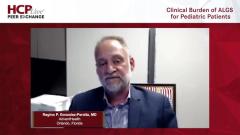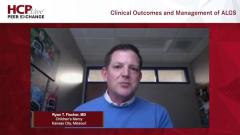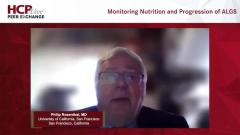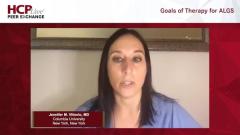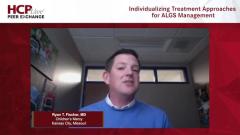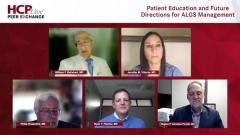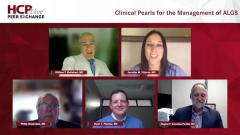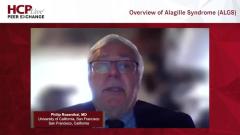
Clinical Outcomes and Management of ALGS
Experts in pediatric hepatology review health complications associated with ALGS and the importance of early diagnosis to manage the disease.
Episodes in this series

William F. Balistreri, MD: Jennifer, I suspect you agree with me. Phil said that when you’ve made a diagnosis, he could sit back and relax. For me it’s, “No, now we’re off to the race.” We’ve got a challenge here. What do you tell the families they can expect in the short term and long term in terms of the clinical outcome and management? Follow that journey a little.
Jennifer M. Vittorio, MD: This is so interesting, because Phil was talking about meeting a lot of these patients early on in the newborn period. There are a number of things that you’re going through. First, they’re dealing with the idea of having a sick child. Then you’re talking about things like biliary atresia, surgeries, and transplants, so it can certainly be overwhelming. Part of the idea of timely diagnosis is so you can help and guide many of these discussions.
Alagille syndrome, as we mentioned, can affect multiple organ systems. However, not all the same organ systems are affected in each individual, even within families. If we focus on the liver, there are a number of health complications that we can start with right there. As we’ve alluded to, Alagille in the liver is often associated with interlobular bile duct paucity, which can lead to chronic cholestasis. You get a buildup of bile acids and then subsequent liver injury.
Some of the focuses, especially early on, have to be on things like nutrition. Nutrition isn’t just because you want a healthy, thriving baby. There are a lot of health implications on brain development and whatnot. With fat-soluble vitamins, we have to be aware and monitor for those to start the right supplements and [to help with] a lot of the sequelae, like neurological deterioration and bone health. The focus is on the impact of this disease on the child when you’re meeting them and how you counsel and go from there.
Up front, there’s a lot of nutritional focus and talking about prognostic factors and things that we’re going to focus on in the future, and then having an awareness of what those things are. Many times, these patients present to us with neonatal cholestasis, but there has to be a level of awareness of making sure and getting that echocardiogram, referring them to the cardiologist when appropriate in doing that counseling.
Another thing you alluded to for better or worse is sometimes having to work with our neurology colleagues. Even though this isn’t necessarily a liver issue, given our experience with things likes Alagille, many of us are aware of some of the vascular complications. You mentioned your patient’s mother, who unfortunately suffered a stroke. Having the wherewithal to know that the screening—the brain MRI—is something that has to be on the table at some point is important as well. Whether or not that’s done early on, it’s done only if the patients are symptomatic. But most of us recommend that as soon as they’re able to sit still without anesthesia, we’re going to at least get a screening MRI of the brain to make sure we aren’t missing anything.
A lot of the practices and protocols that we have to think about to encourage early detection and recognition involve education. [It’s important to] have the awareness that this disorder exists, what it entails, and how it might impact people differently, often making our colleagues in the NICU [neonatal intensive care unit] and hepatology [aware]. These might be patients whom we see fairly often. But for gastroenterologists, that may not be something they come across all that often. When to screen, what to look for, and what things to identify are so important in this field.
William F. Balistreri, MD: Thank you, Jennifer. That’s clearly the point. We’ve talked about making the diagnosis, but the key is to get them into the hands of Dr Rosenthal, Dr Vittorio, and so on. Ryan, what are you doing in Kansas City [at Children’s Mercy Hospital] to get your colleagues to understand on a broader basis that a baby with persistent jaundice shouldn’t be ignored? It’s not breast milk jaundice if it’s conjugated hyperbilirubinemia.
Ryan T. Fischer, MD: As pediatric gastroenterologists at academic centers, this is where we’re getting residents into our hands most days, and you just bang on that drum to say, “Please get that fractionated bilirubin sooner rather than later when you’re evaluating these jaundiced children.” I really like the work that Sonny [Harpavat] is doing at Texas Children’s [Hospital] to bring forth what we need to learn with early screening intervention, whether that represents something like the stool color card that’s come out at different locations or the early screening with direct bilirubin measurements. Because going back to Phil’s point, Alagille is going to be important to diagnose, but we need to get that biliary atresia diagnosis out first and make sure we aren’t missing something that has that time sensitivity to it. Phil, I didn’t hear if you mentioned this: Are you guys using the MMP7 for your work-ups with these kids? If you are, how frequently?
William F. Balistreri, MD: Please say yes.
Philip Rosenthal, MD: Jorge Bezerra from Cincinnati [Children’s Hospital] is the lead on that. From a research standpoint, the answer is absolutely yes. From a clinical standpoint, the answer is no because I don’t think it’s approved in my institution to get that. Someday I hope that will indeed be the case, because there’s value there. But at the moment, that unfortunately isn’t something that I have readily available that I can utilize.
William F. Balistreri, MD: Let’s backtrack for a second. Ryan brought up 2 very important points: the MMP7, which we can finish up with the rest of the panel, and you alluded to Dr Harpavat at Baylor [College of Medicine]. He has simply looked at bilirubin levels in the first few days of life. Because we keep talking about the importance of recognition of biliary atresia. That’s still the No. 1 indication for liver transplant in every one of our centers because of the late diagnosis and the nonuniversal success of the Kasai procedure. That’s one of the most important points about these diseases early on: fractionate that bilirubin. Whether you use bilirubin levels alone or MMP7, which is metalloproteinase that our colleagues are continually using in our patients with biliary atresia, that remains to be seen. But the key is making an early diagnosis. Reggie, Jennifer, any comments before we move on?
Regino P. Gonzalez-Peralta, MD: I agree. Thinking biliary atresia first and everything else later is the right approach, however you do that. There are guidelines that help us, but we all have our own nuances of how things are done based on experience at our centers and those kinds of things that are very individualized. I agree with Phil. The MMP7 story seems to be a good one, but I have the same issues getting samples out. It’s difficult. I’m hoping that it helps. Your thought of combining that with direct bilirubin within the first few days of life to maybe improve the sensitivity of screening would be great.
William F. Balistreri, MD: Thank you, Reggie. Any comments, Jennifer?
Jennifer M. Vittorio, MD: I have to echo exactly what you were saying, Reggie, about a lot of Sonny’s work. Are we going to be moving toward a universal screening? We’re good about getting bilirubin levels. Why not fractionate them? Once you do, there’s that awareness, that directive. Sometimes there’s a lack of awareness. It doesn’t sound that impressive, and it’s mostly indirect, so often that gets overlooked.
As Ryan was saying, for many of us and to our residents, biliary atresia walks in the door almost every day. They’re trained to look for this and think about it even before they’re worrying about their breast milk and whatnot. That certainly speaks to some of the work that our local groups are doing. Getting the word out, we’re going to uncover a lot of these cases a lot earlier. We seem to be doing the Kasai procedures a lot sooner than we have in the past. That speaks volumes to some of the progress we’ve made in this field.
William F. Balistreri, MD: That’s great. The direct relevance is earlier detection of conjugated hyperbilirubinemia means not just biliary atresia detection but the disease that we’re talking about, Alagille syndrome.
Philip Rosenthal, MD: Bill, I’d like to make a comment about bilirubin, because I’ve done a lot of work in the field. The correct term is conjugated bilirubin. That’s what Sonny has been looking at: bilirubin mono- and di-conjugates. Direct bilirubin can even be positive if you have a high indirect bilirubin. You have to be very careful. Most laboratories run direct bilirubin, and one needs to realize that the conjugates are abnormal. As you said, that’s the key. A lot of pediatric hospitals measure total and conjugated bilirubin. That’s the key fraction that’s abnormal when you see biliary atresia.
William F. Balistreri, MD: Thank you, Phil.
TRANSCRIPT EDITED FOR CLARITY
Newsletter
Access practical, evidence-based guidance to support better care for our youngest patients. Join our email list for the latest clinical updates.


